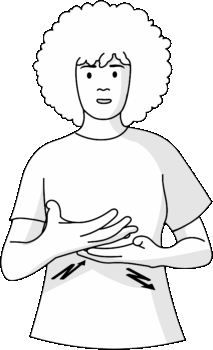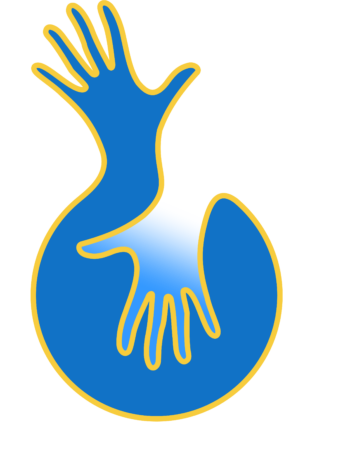The learning objectives of the eight topics in “Sign languages for pupils: Thinking about grammar” serve to build language awareness in pupils aged ten or over.
Learning objectives of the topics
How were the learning objectives defined?
“Sign languages for pupils: Thinking about grammar” does not claim to teach the structures of sign languages in full. In the BAG-Sign project, eight topics were selected based on the following criteria:
- Each topic is suitable for pupils aged ten and over.
- The topics are complex, so teachers need additional material for the lessons.
- The learning objectives can be achieved within lesson time.
Teachers can determine the order of the topics themselves. The chapters within a given topic build on each other. Teachers can decide for themselves how much time to spend on each topic.
How was specialist terminology chosen?
The BAG-Sign project aims to introduce a standardised didactic terminology for grammar lessons in order to describe the structures of sign languages. The technical terms were selected based on the following criteria:
- The selection is didactically motivated: it is appropriate for the age and level of knowledge of the pupils.
- Technical terms are rooted in linguistics but can be used across theories.
- The technical terms have been chosen to enable pupils to develop metalinguistic vocabulary in both their sign language and in their respective written language, so they can reflect on the structures of sign languages.
Teachers can decide for themselves whether they would like to introduce additional, maybe alternative, technical terms.
Learning objectives and notes on the eight topics
Pupils
- are able to distinguish between different types of questions, such as content questions, polar questions, alternative questions, and rhetorical questions;
- know different linguistic means specific to their sign language with which to express these types of questions.
- Asking questions
- Polar questions
2.1 What is a polar question?
2.2 How is a polar question expressed? - Content questions
3.1 What is a content question?
3.2 How is a content question expressed? - Alternative questions
4.1 What is an alternative question?
4.2 How is an alternative question expressed? - Advanced: Rhetorical questions
5.1 What is a rhetorical question?
5.2 How is a rhetorical question expressed?
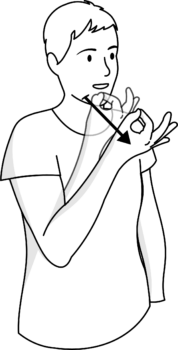
Pupils
- know what negation means;
- are familiar with different linguistic means of expressing negation that are specific to their sign language. These include negation signs, negation with non-manual devices and the negation of modal verbs;
- are aware that linguistic means of expressing negation can be more or less acceptable in formal and informal contexts.
- Negation
- Negation signs
- Expressing negation through a head shake
- Negation through the change of verbs
4.1 Negation of verbs with the alpha-movement
4.2 Negation of verbs by other changes - Emphasis of negation
- Negation in different situations
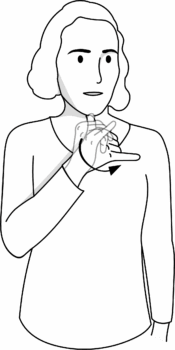
Pupils
- know the meaning of singularity and plurality;
- are familiar with the different linguistic means specific to their sign language for expressing plurality of things and living beings. This includes changing signs for objects and living beings, using number and quantity signs as well as proforms, pointing signs and changing directional verbs.
- Singular and plural
- Modification of a sign for an object or a living being
- Indicating quantities
3.1 Indicating quantities with number signs
3.2 Indicating quantities with quantifier signs
3.3 Indicating quantities with proforms - Pointing signs for several living beings or things
- Modification of directional verbs
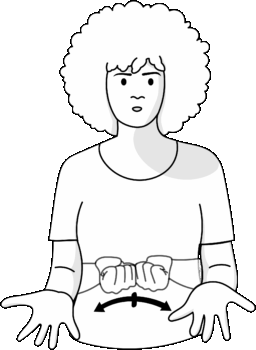
There are various technical terms for directional verbs. These include, for example, “agreeing verbs” or “congruent verbs”.
Pupils
- know different stages of time (past, present and future) and understand that these can be seen from the viewpoint of either the signer or a specific event/subject matter;
- know different linguistic means of expressing time that are specific to their respective sign language, and can use these to express time stages and time relations. This includes the use of timelines and time expressions.
- The three stages of time: Past, present and future
- Timeline
2.1. The sagittal timeline
The sagittal timeline from the viewpoint of the signer
The sagittal timeline from the viewpoint of a specific event/subject matter
2.2. The horizontal timeline - How to establish a point in time on a timeline
3.1. Pointing with the hand on a locus
3.2. Placing a buoy
3.3. Placing a sign - Time expressions
4.1. Positions of time expressions in a sentence or text
4.2 Time expressions on a timeline
4.3. Time expressions without a timeline
4.4. Time expressions with number incorporation - For advanced
5.1. Dividing timelines into time segments
5.2. Showing the duration of an event on a timeline
5.3. Further timelines and timeplanes
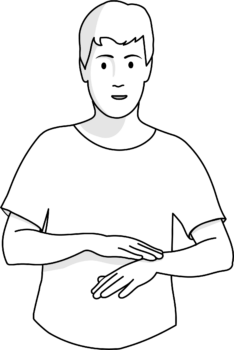
- are familiar with various linguistic means specific to their sign language for referring to objects, people or animals. These include the use of lexical signs and pointing signs, localisation in the signing space, and combinations of role-taking and depiction of situations with proforms.
- Reference – to refer to things and living beings
- Lexical sign
- Pointing signs
3.1. Pointing at things or living beings that are present
3.2. Pointing at things living beings that are absent - Lexical sign and location in signing space
4.1. Lexical sign and pointing at present things and living beings
4.2. Lexical sign and pointing at absent things and living beings - Lexical sign and role taking
- Lexical sign and depiction of a situations
- Only role taking or depiction of a situation

Reference is the linguistic term for the relationship between a linguistic sign (symbol) and the person or the idea of this person to which it refers.
Pointing signs for persons are also referred to as personal pronouns.
- are familiar with the various linguistic means available in their respective sign language for expressing the activities of people, animals or objects. These include the use of lexical signs, role-taking and the use of proforms for representing situations.
- Expressing actions
- Expressing an action with a lexical sign
- Expressing an action from a character point of view: Role taking
- Expressing an action from an observer point of view: Depicting a situation
- Proforms
5.1. Proforms representing persons
5.2. Proforms representing animals
5.3. Proforms representing things - Combinations
6.1. Combinations of lexical signs and role taking
6.2. Combinations of role taking and depicting a situation
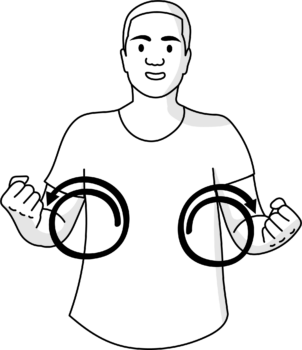
There are various technical terms for role taking. These include, for example, role change and constructed action. We consider manipulators to be a form of role taking.
The term depicting signs is also used for the expression depicting a situation.
Another technical term for proform is e.g. classifier or substitutor.
In French schools, the terms transfert personnel (for role taking) and transfert situationnel (for representing a situation) are established and have therefore been retained for LSF.
Pupils
- know what aspect means and can distinguish between three types of aspect (completed, continuous and repeated);
- are familiar with the different linguistic means of expressing aspect in their respective sign language. These include aspectual signs, changes to the verb and non-manual devices.
- Aspect – The temporal course of an action or state
- The action or state is completed
2.1. FINISH
2.2. HAD/HAVE BEEN
2.3. ALREADY
2.4. Non-manual devices - The action or state is continuing
3.1. Changing of the verb
3.2. ONGOING and YES
3.3. Non-manual devices - The action or state is repeated
4.1. Changing the verb
4.2. Aspectual signs and information on the frequency of repetition
4.3. Non-manual devices
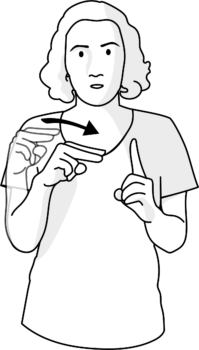
This chapter deals with the temporal aspect. Various types of temporal aspect are discussed in sign language linguistics. Three of the most frequently used types of aspect have been selected for this chapter:
Perfective aspect: the action is completed.
Durative aspect: the action continues.
Iterative aspect: the action is repeated.
Pupils
- are aware that conversation partners can take on different roles in conversations (signer and viewer) and actively organise the course of the conversation with each other.
- are familiar with different linguistic means available in their respective sign language to initiate a conversation, organise the change of conversation contributions (turns) and conclude a conversation.
- Conducting a conversation
- Initiating a conversation
- Turn-taking
3.1. Maintaining the turn
3.2. Handing over the turn
3.3. Taking the turn
3.4. Active watching
3.5. Overlapping turns - Ending a conversation
